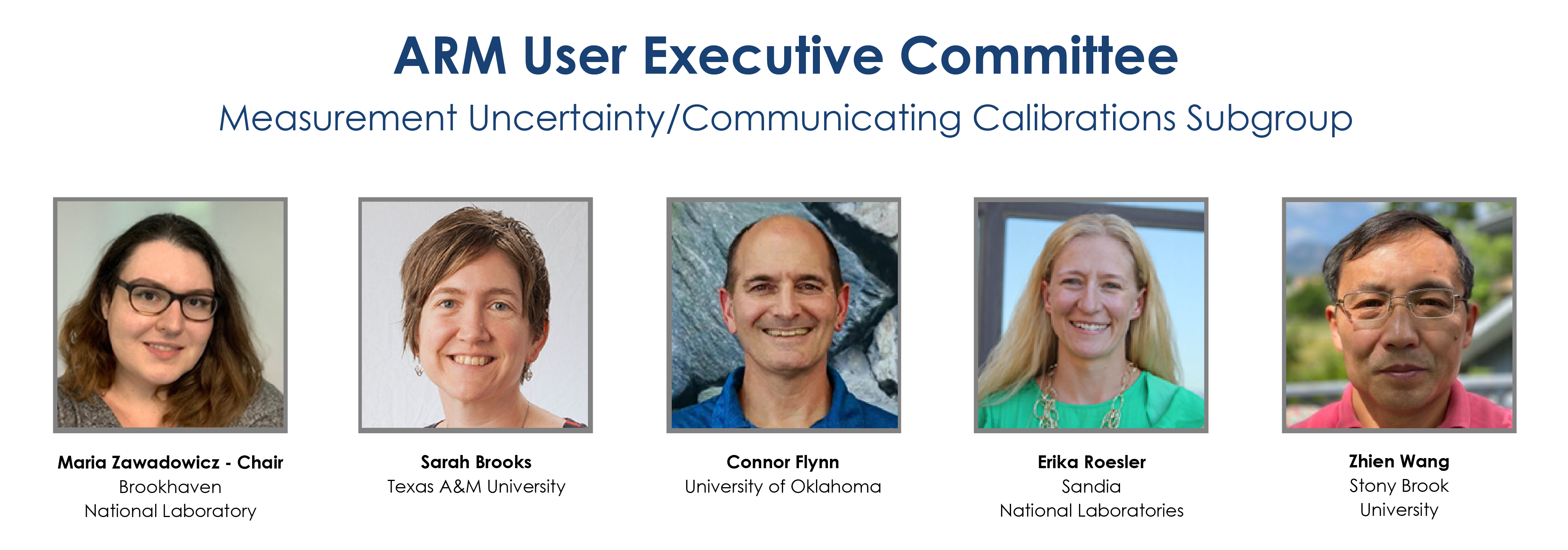From the User Executive Committee (UEC) Subgroup Chairs: April 2024
Published: 25 April 2024
Editor’s note: Members of ARM’s User Executive Committee (UEC) participate in subgroups that aim to help broaden community outreach. In a four-part series of blogs, each subgroup chair during the 2023–2024 UEC term will introduce their subgroup, share their subgroup’s ideas and recommendations to ARM, and ways in which the ARM community can engage with subgroup members. Here, Maria Zawadowicz opens the blog series with an update from the Measurement Uncertainty and Communicating Calibrations subgroup.
The UEC is charged with providing feedback to ARM leadership with respect to the user experience. It is divided into four subgroups, one of which is focused on measurement uncertainty and communicating calibrations. During last year’s hybrid meeting at the Southern Great Plains (SGP) atmospheric observatory, the UEC discussed each subgroup’s progress and recommendations to ARM, which are now summarized in this report. The meeting was a great opportunity to get to know other members of the UEC, including those who participated virtually, and focus on the committee for the majority of two days. We also got some nice tours of the SGP facility.
The members of the UEC Measurement Uncertainty and Communicating Calibrations subgroup are very familiar with using ARM data of various types. Two of us—Connor Flynn and I—also serve as mentors of ARM instrumentation and are therefore tasked with characterizing the calibration and uncertainty of our instruments.

As part of its operations, ARM produces many different kinds of data, including profiles of cloud and precipitation properties from radar; profiles of aerosol properties from lidar; profiles of atmospheric thermodynamics from radiosondes; in situ measurements of aerosol properties such as size, composition, and hygroscopicity; and measurements of atmospheric radiation and gas fluxes. Each of these data products is produced by very different types of instruments with very different principles of operation.
In the cases where two different instruments measure the same property in different ways (e.g., in the case of different instruments used to characterize aerosol size in situ), it is possible to compare the datastreams to understand the individual instrument uncertainties better. For example, a lidar detects aerosol particles by sending out a beam of light and measuring how the light scatters from particles in the atmosphere. On the other hand, an aerosol chemical speciation monitor detects aerosol particles by heating them up to vaporize their components, ionizing the resulting vapors through collisions with electrons and measuring the ion mass. While the particles might be the same, the principles of operation are very different scientifically. This is what makes calibrations and quantification of uncertainties of ARM instruments and communication of these calibrations and uncertainties to data users very challenging.
Recommendations to ARM
During the UEC’s hybrid meeting, we recommended that ARM do the following:
- Collate the calibration information for ARM instruments, and send it to users along with their data order. This information is currently stored in many places, and finding it can be challenging for new users.
- Convene a Data Uncertainty Committee, which would be charged with prioritizing datastreams that need more rigorous estimates of uncertainty and update Doug Sisterson’s report titled “A Unified Approach for Reporting ARM Measurement Uncertainties Technical Report: Updated in 2016.”
- Explore using value-added products to characterize and communicate the uncertainties of instruments and comparisons of different data that measure the same properties. A lot of work on this last recommendation is already underway at the ARM Data Quality Office, which has been exploring the use of machine learning to characterize the uncertainty of certain instruments.
Engage With Us
This subgroup is always interested in hearing from ARM data users about their experiences with measurement uncertainty and/or instrument calibration. Please contact us! We will communicate information from the larger community to the rest of the UEC.
Keep up with the Atmospheric Observer
Updates on ARM news, events, and opportunities delivered to your inbox
ARM User Profile
ARM welcomes users from all institutions and nations. A free ARM user account is needed to access ARM data.


















